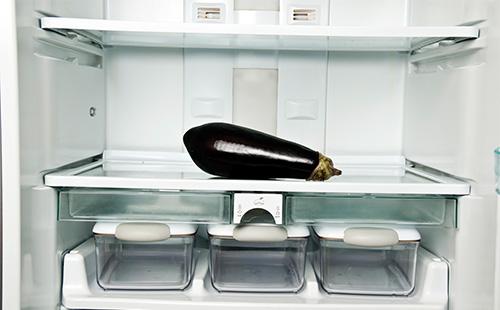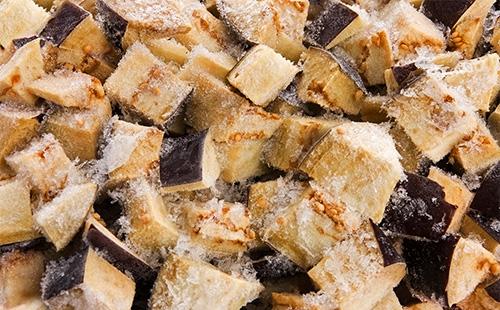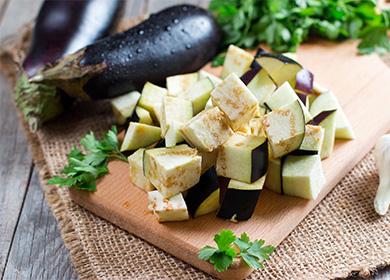This vegetable should not be underestimated. If you think that just cutting it into cubes and sending it to the freezer is enough, you are deeply mistaken. After defrosting, the little blue pieces will be bitter. So, nothing good can be prepared from them.
It is believed that freezing eggplant for the winter at home involves exclusively soaking the vegetable in saline. Allegedly, to get rid of the same annoying bitterness. But this is not an option: the thawed product by consistency will look more like mashed potatoes than individual pieces of your favorite vegetable. For caviar, of course, this will do. But you won’t fry the purée blue with the garlic and season with sour cream. You can save eggplants for the winter in the freezer in various ways. The main thing is to correctly implement your chosen procurement method.
Reasons to love the blue fruit
As soon as they do not call eggplant: Pakistan, and licked, and blue, and demyanka, and badorzhan. But the essence of the change of names still does not change, and the fact remains: this vegetable is not only tasty, but also healthy. However, not without contraindications, of course.
What is useful ...
Dark nightshade nightshade, which is the name of the eggplant in a scientific way, is rich in micro and macro elements, without which the human body is unable to function normally. But its value is not only in this.
- Vitamins of group B. This vitamin group is famous for its beneficial effects on the human nervous system. Therefore, eggplant is a natural pill for stress and depression, which people are especially susceptible to during the cold season.
- Folic acid. The high content of this acid makes the little blue must-eat product for pregnant women. The substance contributes to the high-quality intrauterine development of the baby and partially removes the load from the mother's body.
- Vitamin C. It turns out that for regular prevention of viral ailments, it is enough to eat two eggplants per week. High levels of vitamin C help strengthen the immune system and protect against viruses.
- Zinc and Manganese. These two trace elements are necessary for everyone. But especially to those who have recently suffered a stroke and are in the rehabilitation phase.
... and what is harmful
The favorite delicacy of many - eggplant fried in a large amount of vegetable oil - unfortunately, does not carry any benefit in itself. Pieces of the vegetable during the heat treatment are thoroughly saturated with toxins released from the oil, which later get into our stomachs together with the vegetable. Therefore, intending to cook frozen eggplant, seven times think about how to do this, in order to preserve all the usefulness of the vegetable. There are two more nuances to be aware of.
- Solanin. Another minus of the little blue ones is the ability to accumulate poison called solanine, contained in potatoes with green sides and provoking vomiting and diarrhea. Solanine is formed in overripe vegetables, so it is recommended to eat only young eggplants.
- Low carbohydrate content. What is good for some is fraught with hypoglycemia for others. So with eggplant: a healthy figure-minded person will benefit from an abundance of this product. But a person suffering from diabetes mellitus, on the contrary, is harmful: a small amount of carbohydrates can provoke hypoglycemia - a condition in which the level of glucose in the blood becomes critically low.
Permissions and Prohibitions
But the little blue ones, living on almost every summer garden and perfectly taking root on the domestic black soil, are some of the lowest-calorie vegetables. In 100 g of pot-bellied product, only 24 kcal. Therefore, do not be surprised if you find a lot of eggplant diets and positive reviews about them on the Internet.
But such power systems are not suitable for everyone and not always. The table will tell you under which diseases the consumption of blue ones in food is vital, and in which cases a vegetable with a purple skin should be flatly abandoned.
Table - Permissions and prohibitions on eating eggplant
| The use of little blue | Painful conditions |
|---|---|
| It is possible and necessary | - Anemia; - gout; - atherosclerosis; - problems with sleep; - depression; - ischemia; - renal disease; - constipation; - problems of the cardiovascular system |
| In moderation | Diabetes |
| Prohibited | - Pathology of the gastrointestinal tract; gastritis - stomach ulcer |
How to freeze eggplant for the winter in the freezer
- Eggplant is a special vegetable that requires mandatory heat treatment before freezing. Otherwise, its taste will be similar to that of a rubber boot. In other words, raw eggplants never freeze. And if they freeze, then only out of ignorance. In addition, the fruits for freezing should be wisely selected.
Vegetable Casting
Your first task is to organize a casting for the little blue ones. Not everyone deserves to turn into a blank, but only the elite. The selection criteria are the same as in the case of conservation.
- Tail. The peduncle should have a green color. It is better to eat a vegetable with a dry peduncle right away: a dried tail is evidence that the product has been stored for quite some time in isolation from the bush.
- Uniformity of color. The color of the eggplant should be uniform.
- Surface. A glossy finish, devoid of cones, growths, spots and damage - this is what a vegetable ideal for freezing should look like.
- Age. It is desirable that the fruits are young. Large and ripe vegetables contain a lot of seeds. They are tougher both inside and out.
Process features
When freezing, it is important to observe the tightness rule. The packaging in which the pieces of vegetables are placed must be tightly closed to prevent the eggplant from coming into contact with the air in the freezer. This will protect the product from oxidation, as well as from the absorption of extraneous odors. You do not only store blue ones in the freezer, right? This and other “laws” will allow you to freeze eggplants correctly regardless of the method you choose.
- Soaking. Due to the refusal to pre-soak the fruits will remain bitterness. And you hardly want to eat a bitter product. Therefore, before freezing and obligatory heat treatment, soak pieces of blue in salt water or sprinkle with table salt on top. After half an hour, the product will be enough to simply rinse under running water.
- Moisture removal. Before laying in the freezer, the eggplant circles must be dried by eliminating the water that has come out or the vegetable oil that has lingered on it from their surface. This is easy to do with kitchen paper towels.
- Label. A plastic container or bag with eggplant should be signed. Covered with hoarfrost in the freezer, all products will be on one face.And to distinguish what package contains will be extremely difficult.
Harvesting Methods
We’ll start the conversation about the preparation from the end. Namely, how, without having a vacuum in the house, pack vegetables tightly. To do this, you will need a package with a zip-fastener and a regular cocktail straw. Close the bag almost to the end, leaving only a small hole. Insert a plastic tube into it, pull the air out of the bag with your mouth, and, finding that the polyethylene has stuck to the eggplant, remove the improvised “air suction”, closing the rest of the package. That's all. And now about the main thing - how to freeze fresh eggplant for the winter.
Fried
- We wash our little blue ones and cut them into round circles no more than 7 mm wide. Too thinly sliced eggplants become thinner when frying and become unsuitable for storage in the freezer.
- Sprinkle with salt and wait about half an hour until bitterness comes out. After washing under running water.
- Put the rounds on the grill or other impromptu "bed" and leave until completely dry. Vegetables can be helped with drying by patting them with a paper towel.
- Pour a couple of drops of oil onto a preheated pan and fry pieces of blue on both sides in just a few minutes. A light golden crust will be a signal that vegetables should be removed from the pan.
- We put the finished pieces on the grate, let it cool completely and send it to the freezer with a temperature below -12 ° C.
- After an hour and a half, we take out the grate, remove the frozen fried eggplant from it and pack it in bags, sending it back to the conditions of eternal cold until winter.
- We stick all the packages with vegetables, signing what is in the bag, in what form and with what weight.

Baked
- We cut the little blue circles or slices. For example, for the preparation of rolls in the future, slices are just right.
- We heat the oven to a temperature of 180 ° C and send the eggplants in the heat for 30 minutes, laying them on a greased baking sheet with vegetable oil.
- In order for the blue ones to brown well on both sides in the oven, after 15 minutes, turn them over to another barrel.
- Next, we do the same thing as in the case of fried eggplant: leave it to dry, send it to the freezer for half an hour, put it in bags, remove the air, stick it and back to storage in “permafrost”.
Braised
- Heat a little vegetable oil in a saucepan.
- We spread the cut eggplants and simmer them until cooked, stirring occasionally. Salting and pepper are optional, but you can if you wish.
- Remove from the stove, let cool completely.
- We transfer the stewed eggplant caviar into a container or storage bag and put it in the freezer.
Blanched
- We boil water in a saucepan, salt it well and add a tablespoon of lemon juice or the juice of half of fresh lemon.
- We put chopped vegetables in boiling water and boil for five minutes.
- Using a slotted spoon, we take out pieces of blue ones and immediately lower them into a vessel with ice water.
- We take out, dry and get a product completely ready for freezing.
Boiled
- We remove the stalk from vegetables, in several places we pierce the fruit with a toothpick or needle deep enough, and then we put them in saline to remove the bitterness.
- Leave the vegetables in salt water for 45 minutes. In this case, more time is required, since the eggplant is not chopped and processed whole.
- We boil water in a saucepan and for 20 minutes we send there the blue ones saved from bitterness.
- After cooling, the wrinkled fruits will remain cut into your preferred method and freeze.
Whole
- Without peeling the vegetable, we succumb to its heat treatment.This can be stewed whole in a slow cooker, grilled or cooked, as in the previous version.
- After heat treatment, allow the vegetable to cool and pat it with paper towels to eliminate moisture from the surface.
- Each individual vegetable is wrapped in several layers of cling film and sent to the freezer.
Defrost by the rules
Vegetables belong to the category of products, which can be frozen only once. So, after the eggplant has thawed, it is forbidden to send them back to the freezer. Therefore, it is so important to pack the little blue ones before freezing in portioned packets - so that, if necessary, you can defrost as much product as you need at a particular moment. Further, there are two possible scenarios.
- Defrosting at room temperature. Take the little blue ones out of the freezer, put on a wide plate and leave to thaw without using any auxiliary electrical appliances.
- Cooking without defrosting. Some dishes from frozen eggplant and zucchini do not require preliminary defrosting. Therefore, the product can be sent to the pan or to the pan to other ingredients directly in frozen form.

Cooking options
There are a lot of recipes in which solanaceous turned into ice are involved. But not all of them are successful and tasty. The table below offers you the most profitable options for cooking frozen eggplants, indicating which vegetables are sliced and which heat treatment is most suitable for preparing a dish.
Table - Cooking options for frozen blue
| Dish | Recipe | Type of frozen product |
|---|---|---|
| Vegetable Caviar | - Stew eggplant along with other vegetables; - when ready, beat the vegetable mass in a blender at low speeds | Any |
| Cheese "turrets" | - For each piece of eggplant, put a round tomato; - we form multilayer "turrets"; - sprinkle with grated cheese on top; - bake in the oven for 15 minutes | Fried or baked round balls |
| Rolls | - Three grater cheese; - add chopped garlic and herbs; - grease each slice with sauce and wrap it in a roll; - if necessary, fix with a toothpick | Fried or baked slices |
| Pot roast | - Lightly fry potatoes and meat separately in a pan; - we put products in pots for baking; - add the onions and carrots; - Top with eggplant in each pot; - overwrite with cheese; - grease with sour cream; - put in the oven for an hour and a half | Cubes of any processing |
Eggplants removed from the freezer can be used in the same way as fresh vegetables. However, the palatability of the frozen blue ones is not so pronounced and strong as that of the "brothers" recently plucked from the garden. Therefore, if there is an opportunity to purchase fresh high-quality eggplants at the supermarket, give preference to this option. Well, if not, frozen slices or rounds can easily diversify your winter diet.
Experienced housewives noticed that mainly late vegetables or overripe fruits are very bitter. This is another argument in favor of freezing eggplant young. And for those who are crazy about vegetable stew, there is a proposal to freeze a variegated “cocktail” in which the little blue ones are next to onions, bell peppers, zucchini, a pot and any other fruits from the garden.
Reviews
I soaked them with strips, circles, and cubes today, and when I presented them and crushed the cubes in the oven, those places where there were seeds .... they simply are not possible, sheer bitterness (((I wasted my time, everything was in a bucket! Raw eggplant you can try for bitterness, so that since I do not waste time in vain.
Anna Averina, https://menunedeli.ru/2011/09/kak-zamorozit-baklazhany-s-poshagovymi-foto/
For many years I have been freezing raw eggplant, diced, and in the winter I cook vegetable stew or add to soup sauce.Eggplant contains little water, it's not zucchini! Although I freeze zucchini, and in winter I stew carcasses with eggplant and bell pepper. And add frozen dill, basil and parsley. The real taste and aroma of summer! The main thing - do not defrost vegetables before cooking - and everything will be fine. Nothing has ever spilled or spread.
Olga http://home-restaurant.ru/zagotovki-na-zimu/kak-zamorozit-baklazhany-proverenny-j-sposob-s-foto
Eggplant is always delicious. They can be preserved, frozen and eaten pickled. Sometimes they taste like mushrooms, but they are vegetables. The only taste flaw is bitterness, which is removed by salt and ordinary running water.
Hope, https://mamapedia.com.ua/health/polza-ili-vred/baklazhany.html
Not the first year I freeze vegetables, fruits, berries in a large no frost freezer. I peel the eggplant, cut it into cubes and small portions in a breakfast bag. I remove air from the bag as much as possible and seal it with an iron through a sheet of paper. Then nothing is bitter, for stews and casseroles the taste is excellent. Frozen in circles - not really liked it. Perhaps because it was frozen in a bag on a clip, and not hermetically in a sealed bag. But this year they found application for them: frozen circles - in a pan (do not salt !!!), fry until tender. Put feta or any very salty soft cheese mixed with mayonnaise on top. Above is a frozen circle of tomato. While the tomato is thawing, the excess salt from the cheese will turn into eggplant and tomato, and the taste will be balanced. The winter alternative is blue with tomato, mayonnaise and garlic, only tastier!)
Evgenia Kiseleva, https://menunedeli.ru/2011/09/kak-zamorozit-baklazhany-s-poshagovymi-foto/
Other homemade recipes
Eggplant in adjika for the winter
Eggplant like mushrooms for the winter
Dandelion jam
Sea buckthorn jam

